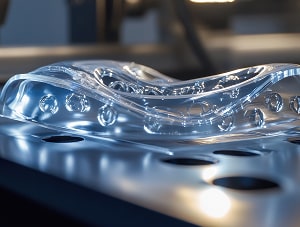
A vacuum casting machine can be used for producing precise silicone tools for casting elements having outstanding details and extremely thin walls. Vacuum castings are exact copies of shapes, dimensionally correct without any imperfections, and with just about every profile and texture consistently modeled.
Vacuum casting calls for a starting expense of the vacuum chamber with two sections. The top section performs the blending in the resin. The lower does the casting with the resin into the mould.
Vacuum casting steps
- The procedure used by a vacuum casting machine consists of nine steps.
- The initial action is going to be to generate a routine producing use of any existing RP method (SLA, SLS, FDM, etc.)
- The pattern will probably be fitted using a casting gate and established on the parting line, soon after which it’s suspended inside a mould casting frame.
- At this point, the two-part silicone-rubber has all air eliminated, then is mixed and poured in to the casting frame around the routine. The mould is then cured inside a heated chamber.
Following curing, the pattern is cut along the parting line and eliminated. The resin is portioned, colour dye is added if necessary and casting funnels put in place. Soon after this the mould is closed and sealed. Digitally controlled equipment combines and pours the resin to the vacuum chamber. Due to the fact that this happens within a vacuum, the mould is packed totally, with no air pockets or voids. Following casting, the mould is transferred on the heating chamber and left for between two and four hours to cure the urethane component.
Following solidification, the casting is taken from the silicone mould. The gate and risers are sliced off to build a best duplicate on the routine. If needed, the component part is painted or plated.
Utilisation of vacuum casting machine
Using a vacuum casting machine is usually an optional way of producing a prototype casting that imitates injection moulded elements like ABS, PP, PMMA, PA and different types of rubber. Making use on the MCP Heated Cup Module, complicated, precise wax designs for investment casting may be created.
Resins for vacuum casting machine
Resins utilised in a vacuum casting machine are under constant development. Everything from pliable rubber elements to flexible eyeglass lenses, to engine covers on lawn mowers and crash test automotive components are produced through vacuum casting.
Vacuum casting continues to be the very best practice for making plastic prototype elements within 24 hours and can imitate the look and qualities of most plastics, rubber and glass.
With the fit as well as feel of the hard polypropylene, the newest materials are nicely suited for prototype too as short series manufacture of bumpers, dashboards, bump strips and side mirrors.
Additionally, it may possibly be filled using a selection of fillers to produce a firmer substance for the manufacture of prototype hand drill bodies, along with other casings.
Other vacuum casting resins consist of those that fulfill FDA and UL94V0 requirements, some that offer heat deflection temperatures as high as 130C, and optically clear resins.
The majority of resins used in a vacuum casting machine are pigmented and may be precisely matched to every single pantone or RAL tone utilising colour matching processes.
Find out more JH May’s rapid prototyping, which includes the use of a vacuum casting machine.